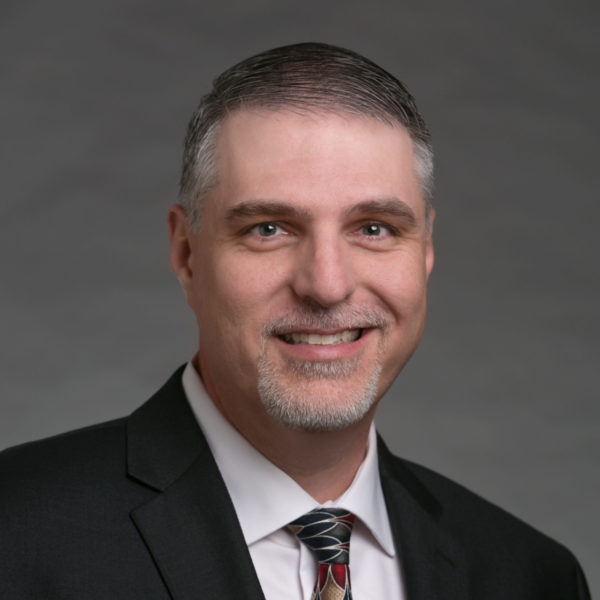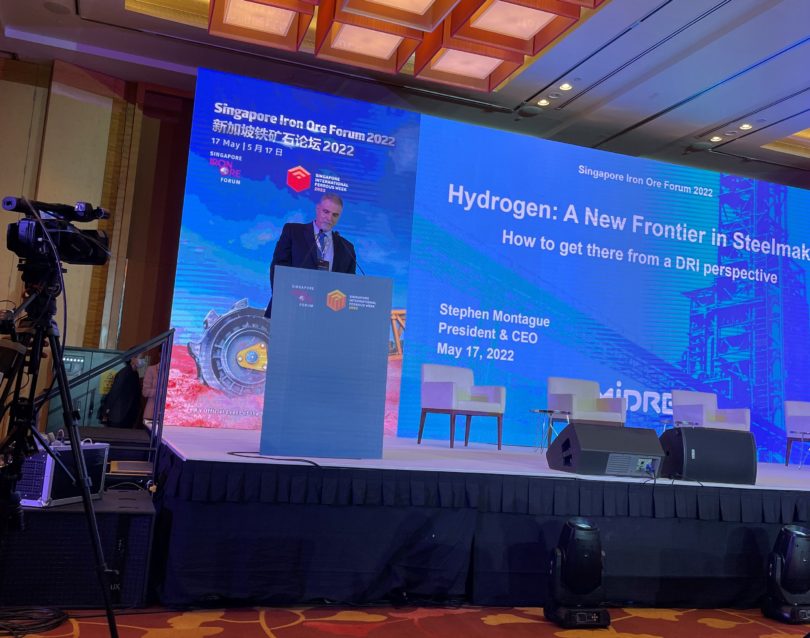Stephen Montague speaks at Iron Ore Forum during International Ferrous Week

Stephen Montague, President & CEO of Midrex Technologies, Inc., was invited to speak at the Singapore International Ferrous Week. He presented during the Iron Ore Forum on the topic "Hydrogen: A new frontier in steelmaking. How to get there from a DRI perspective"
Stephen Montague, President & CEO of Midrex Technologies, Inc., spoke at the Singapore Iron Ore Forum 2022 on May 18, on the topic “Hydrogen: A new frontier in steelmaking. How to get there from a DRI perspective.” Montague said decarbonization of the global steel industry will be a long journey, with several mountains to climb. The winners will be those who start the journey early, are willing to break from traditional industry norms, and select the best technologies.
He said MIDREX® Direct Reduction Technology is actively engaged in reducing CO2 emissions. A MIDREX NG™ (natural gas) plant already uses 55-75% hydrogen in its reducing gas. With hydrogen addition, which can be achieved with little or no modification to the plant, up to 100% of the natural gas can be replaced. The MIDREX Reformer is designed to convert high percentages of CO2 into reusable reducing gas. For plants built to operate on 100% hydrogen from the outset, MIDREX H2™ is available with a specifically-designed electric heater.
Montague provided a glimpse into the future of iron and steelmaking. He said direct reduction has a leading role to play in decarbonizing the industry. We should expect the first large-scale “lighthouse” projects using hydrogen-based direct reduction technology to begin construction in the next 12-24 months. These projects will utilize electric heaters and produce green HBI/green steel. A new market will also develop for using HBI in existing blast furnaces as a transitional solution to lower CO2 emissions in existing blast furnaces. A new large-scale melter, optimized for direct reduced iron (DRI) produced from lower Fe pellets, also is not far away, possibly in the next 12-24 months.
He closed his presentation with a suggestion that it is time for more iron ore companies to venture downstream and participate in large-scale direct reduction projects to supply low CO2 metallics to steelmakers around the world. Likewise, more of the existing ironmakers should become involved in offshore ventures where energy and logistics can be optimized to produce low CO2 metallics.
Founded in 2013, Singapore International Ferrous Week (SIFW) (formerly Singapore Iron Ore Week) is the annual flagship event for the global iron ore and steel industry to discuss and debate the latest industry trends and market developments.
As the anchor event of SIFW, Singapore Iron Ore Forum (SIOF) has grown in stature to become one of the world’s leading iron ore and steel event, establishing itself as the global platform for promoting and deepening industry-wide operation amongst industry, government and businesses. SIOF hosts top business leaders, industry experts, investors, traders, miners, procurement managers and government officials from the region and beyond. It engages industry leaders on trending topics in the iron ore and steel sector with a focus on the changing global trade flows and practices amidst higher geopolitical tensions, digital adoption and environmental consciousness.
Five takeaways from Singapore Iron Ore Forum 2022*
The Singapore Iron Ore Forum took place on May 17, kicking off the SGX-organized Singapore International Ferrous Week. Here are five key takeaways from the event:
All eyes on China ‘s lockdowns
The outlook for iron ore prices hinges on when China emerges from localized lockdowns to combat COVID-19 outbreaks, said Ian Roper, commodity strategist at Astris Advisory Japan KK, in “a world full of risks at the moment.” The longer controls remain in place in China , the more iron ore inventory could build in ports and on ships in port queues amid weaker demand in China , he said. “Once China gets through this current COVID wave, there is real underlying steel demand there,” said Rod Dukino, vice president of iron ore sales and marketing at BHP , adding this would be supported by Chinese government policies. “We will see steel demand redistribute into the second half of the year and possibly into financial year 23,” he added.
Market seen bullish in H2
Rio Tinto expects overall demand for iron ore for the rest of 2022 to be offset by scrap usage and non-restocking of iron ore to 2021 levels, said its head of commercial in China , Sheng Chen, but “steel demand and consumption will rise moderately.” Amid the mostly positive outlook, Chen noted that Rio Tinto ‘s Pilbara operations will ramp up production at the Gudai-Darri mine in the second half of 2022, allowing it to keep to its iron ore production guidance of 320 million-335 million mt for 2022. Post-pandemic, while nations resume normal economic activity, supply chains will face challenges as the pace of recovery varies from country to country, Chen added.
ASEAN seen as growth area
Although China has been the main driver of iron ore demand for the last 20 years, demand could evolve as investments pick up in Association of Southeast Asian Nations or ASEAN countries, Astris Advisory’s Roper said. BHP ‘s Dukino also said the region will see strong growth as BHP expects a threefold increase in steel production up to 2050 in Southeast Asia . The increase in Southeast Asia will translate into growth for the seaborne iron ore market, he said, noting a “flurry of greenfield and brownfield investments” in Indonesia , Malaysia and Vietnam . “We see this as a bright spot region for growth,” Roper said. A lot of Rio Tinto ‘s Chinese customers are investing in the region, Rio Tinto ‘s Chen said.
‘Green’ steel on the radar
“The demand for low-carbon steel, or even zero-carbon steel, will keep increasing as all companies and countries are striving and pushing forward on the low carbon journey,” Rio Tinto’s Chen said. Decarbonization of the steel industry will be a long journey, said Stephen Montague , CEO of Midrex Technologies, noting there are several mountains to climb to achieve the goal. BHP has commissioned five LNG -fueled ships to transport iron ore, the first of which is plying the Port Hedland -Asia route with a 30% reduction in carbon emissions. The second vessel will arrive by end May and the final three by end 2022.
Russia -Ukraine war changing routes
Sanctions on Russia could potentially disrupt up to 5% of global steel output, but so far Russian sellers appear to have found alternative markets. Astris Advisory noted that nonetheless, coal and ferrous trades have been affected due a lack of logistics needed to switch export routes to the Russian east coast. Also, global scrap markets are likely to face tight availability as Russia and Ukraine were major exporters of semi-finished steel and pig iron . For metallurgical coal , Russian east coast volumes (40 million mt/year) will switch to China and India for the near term. The opening of the new Mongolian Tavantolgoi-Gashuunsukhait railroad line could see coking coal exported to China this year, which S&P Global Commodity Insights’ data placed at 36.7 million mt.
*Source: PLATTS – STEEL MARKETS DAILY 18/05/2022
